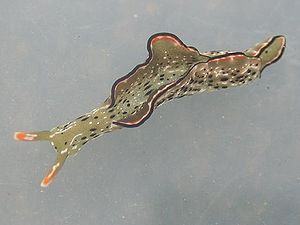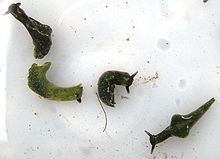Plakobranchidae
| Plakobranchidae | ||||||||||||
|---|---|---|---|---|---|---|---|---|---|---|---|---|

Elysia ornata |
||||||||||||
| Systematics | ||||||||||||
|
||||||||||||
| Scientific name | ||||||||||||
| Plakobranchidae | ||||||||||||
| Rank , 1829 |
The plakobranchidae ( Syn. : Plakobranchidae, Elysiidae) are approximately 100 species, the largest family from the subordination of living in the sea sacoglossa (Sacoglossa).
features
Plakobranchidae are nudibranchs that have completely reduced their shells (as opposed to other Sacoglossa families, which only partially reduced their shells). Their bodies are elongated and slender. On each side there are flat, wing-like parapodies that stand upwards and meet in the middle with their wavy edges. They start behind the neck; Parts of the digestive glands and genital organs extend into the parapodia. Plakobranchidae are hermaphroditic, their genital system is diaulic or triaulic, the penis is not reinforced. A narrow furrow runs down the sides of the body to the sole of the foot, which it then crosses. Usually above this furrow on the right side of the body is the anus .
The pinnacle gill system lies on the surface of the back and extends to the renopericardial elevation immediately behind the head. There are only one pair of head tentacles, the rhinophores , they serve as chemoreceptors and can be rolled up.
Way of life
All Plakobranchidae live in the sea. Like almost all shell-less gavers, they feed exclusively on algae, mostly from the class of Ulvophyceae and Chlorophyceae . In many cases, the individual genera specialize in certain algae orders.
Often, especially in the Elysia species, there is kleptoplasty , so the animals take on algae, but digest for photosynthesis competent chloroplast not, but can continue to operate these in their bodies photosynthesis. This means that, depending on the species, they do not have to eat anything from a few days to several months. For Elysia chlorotica , it was discussed whether the animals not only absorb the plastids of the alga Vaucheria litorea into their bodies, but also integrate parts of the algae genome into their own. This appeared to be conclusive, since the plastids cannot survive without a constant supply of repaired proteins. However, the snail does not appear to be producing the proteins - the reason why the plastids survive for such a long period remains unexplained.
Systematics
The family currently contains five genera with around 100 species, the most extensive is the Elysia with 65 species in the Indo-Pacific alone. However, this genus is in urgent need of revision. Thus, the Placobranchidae also represent the largest family of the gullet snails (Sacoglossa). The Placobranchidae are the nominate family of the superfamily Placobranchoidea, which also contains the families Boselliidae Marcus, 1982 and Platyhedylidae Salvini-Plawen, 1973.
- Elysia Risso, 1818
- Thuridilla Bergh, 187
- Elysiella Bergh, 1872
- Pattyclaya Marcus, 1982
- Placobranchus van Hasselt, 1824
Individual evidence
- ^ A b c Kathe R. Jensen: Anatomy Of Some Indo-Pacific Elysiidae (Opisthobranchia: Sacoglossa (= Ascoglossa)), With A Discussion Of The Generic Division And Phylogeny In: Journal of Molluscan Studies, 58, pp. 257-96, 1992
- ↑ Kathe R. Jensen: Evolution of the Sacoglossa (Mollusca, Opisthobranchia) and the ecological associations with their food plants In: Evolutionary Ecology, 1997, 11, pp. 301-335
- ↑ Mary E. Rumpho, Farahad P. Dastoor, James R. Manhart, Jungho Lee: The Kleptoplast , p 456, In: Robert R. Wise, J. Kenneth Hoober (ed.): The Structure and Function of plastid , 2007 , ISBN 978-1-4020-4060-3
- ↑ Mary E. Rumpho, Jared M. Worful, Jungho Lee, Krishna Kannan, Mary S. Tyler, Debashish Bhattacharya, Ahmed Moustafa, James R. Manhart: Horizontal gene transfer of the algal nuclear gene psbO to the photosynthetic sea slug Elysia chlorotica In : Proceedings of the National Academy of Sciences , 105, 2008, pp. 17867-17871
- ^ Wägele et al .: Transcriptomic evidence that longevity of acquired plastids in the photosynthetic slugs Elysia timida and Plakobrachus ocellatus does not entail lateral transfer of algal nuclear genes . Molecular Biology and Evolution (2010)
literature
- Philippe Bouchet and Jean-Pierre Rocroi: Part 2. Working classification of the Gastropoda . Malacologia, 47: 239-283, Ann Arbor 2005 ISSN 0076-2997
- Kathe R. Jensen: Phylogenetic Systematics and Classification of the Sacoglossa (Mollusca, Gastropoda, Opisthobranchia). Philosophical Transactions, Series B Biological Sciences, 351 (1335): 91-122, London 1996 ISSN 0080-4622 , ISSN 0962-8436
